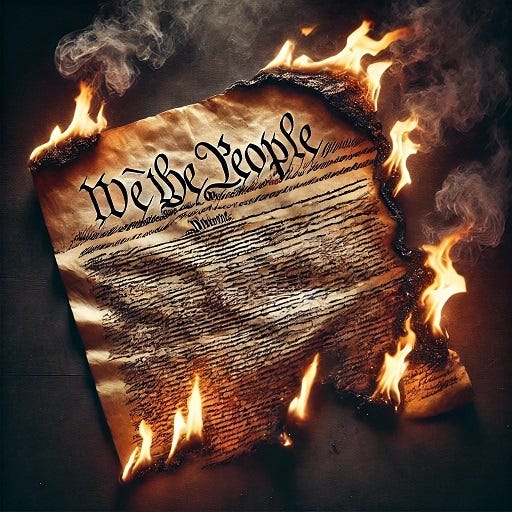There’s an old saying: To a man with a hammer, everything looks like a nail. In times of uncertainty, authoritarian power becomes the hammer, and every challenge—whether immigration, civil unrest, or the specter of war—becomes the nail—an excuse for expanding executive authority. When leaders frame these issues as existential threats, the temptation to bypass democratic institutions and invoke emergency measures becomes irresistible.

Martial law has long been seen as an extreme measure, invoked only in moments of true national crisis—during invasion, insurrection, or catastrophic disaster. In the United States, it has historically been viewed as a last resort, a temporary suspension of civil authority in the face of overwhelming chaos.
But what happens when every political challenge is deliberately framed as an emergency?
When an administration habitually describes immigration as an “invasion” or warns of an impending World War III, it transforms the perception of crisis from a rare occurrence into a constant state. And if everything looks like an existential threat, then the use of extreme powers—like deploying the military against civilians or declaring martial law—starts to seem not just possible, but inevitable.
This is the logic of authoritarianism: convince the public that the nation is under siege, then claim that only a strong, decisive leader—free from bureaucratic constraints—can save it. The danger is not just that crises may be exaggerated or manipulated; it is that they normalize the idea that democracy itself is inadequate to handle them. Over time, the public becomes conditioned to accept emergency powers as the default response to political and social challenges. The greater the perceived threat, the weaker the resistance to executive overreach.
In theory, martial law is meant to be a temporary measure, implemented only when civilian government can no longer function. In reality, history has shown that once leaders seize extraordinary powers, they rarely relinquish them easily.
Consider the scenarios in which an administration might justify its use: mass protests and social unrest could be declared a national security crisis requiring military intervention; a contested election might lead a president to refuse to leave office under the pretense of preventing fraud or instability; a cyberattack or foreign conflict could provide cover for broad emergency powers that suspend normal governance. Under any of these circumstances, the erosion of democratic institutions would accelerate.
Ordinarily, the system of checks and balances—Congress, the courts, the military, and the states—would stand in the way of such a power grab. But these safeguards are weakening. A judiciary increasingly shaped by partisan loyalty may hesitate to challenge executive authority. A gridlocked Congress, paralyzed by political dysfunction, may fail to assert its constitutional role. Military leadership, if filled with loyalists, may no longer act as a neutral force. State governments, while positioned to resist federal overreach, could find themselves overridden by federalized National Guard units. And the media, the last defense against unchecked power, is already under siege by disinformation, attacks on press freedom, and efforts to delegitimize its role as a watchdog.
The legal mechanisms for emergency rule are already in place. The War Powers Act, the Insurrection Act, and other national security provisions give the president significant authority to deploy the military domestically and override normal legal processes. But these laws were drafted under the assumption that those in power would use them in good faith. In the hands of a leader who subscribes to the unitary executive theory—which asserts that the president has near-total control over the executive branch, including law enforcement and the military—these provisions could be stretched to justify prolonged rule under emergency conditions. If the courts do not intervene, if Congress does not act, and if the public is conditioned to accept crisis-driven governance, the transition from democracy to authoritarian rule could happen faster than you can imagine.
The question is no longer whether martial law could be misused in the United States, but how to prevent its abuse before the moment arises.
Rebuilding democratic guardrails requires more than faith in the system; it demands active reform. Congress needs to reclaim its oversight role and impose stricter limits on executive emergency powers. Electoral integrity must be protected against manipulation. The military and judiciary must remain independent, resisting political influence. State and local governments must be prepared to serve as counterweights to federal overreach. And most importantly, the public must resist the creeping normalization of emergency rhetoric. A free press and an informed citizenry are the best defense against a government that seeks to govern by fear.
The troubling reality is that we are already wading into the Rubicon, step by step. The erosion of democratic guardrails is not a distant warning—it is happening now. If Congress does not reassert its role, if courts continue to bend to political influence, if elections remain vulnerable to manipulation, then the moment of no return will not be marked by a single dramatic event—it will be recognized only in hindsight, when it is too late.
As I’ve stated in earlier essays, democracy does not collapse overnight. It erodes gradually, often under the pretense of restoring order or responding to crisis.
The invocation of martial law has always been framed as a necessary response to chaos, but the real chaos lies in the unchecked accumulation of power. If the United States is to avoid crossing the line from democracy to dictatorship, the time to reinforce its institutions is not when the emergency is declared, but now—while the choice remains in the hands of the people, rather than in the grip of a single leader.
If the warning signs are already in front of us, what will it take for us to act before it’s too late?
I also invite you to take a look at this site- www.whatfinger.com





No comments:
Post a Comment